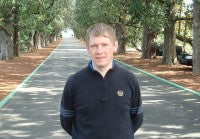Virginia - Plain and Simple ...
 Here in Virginia we have been hit by the downturn in the economy, even though we are close to Washington DC and, therefore, you would think, somewhat protected from it. We have particularly felt the affect with reduced numbers of rounds and quieter days.
Here in Virginia we have been hit by the downturn in the economy, even though we are close to Washington DC and, therefore, you would think, somewhat protected from it. We have particularly felt the affect with reduced numbers of rounds and quieter days.
In 2009 the aim for us at Robert Trent Jones Golf Club (RTJGC) was to continue to maintain the course to championship standards. This is where we have built our reputation, under the expert guidance and management of Course Superintendent, Scott Furlong CGCS, and, as his Senior Assistant Superintendent, we have both had to deal with keeping up the level of maintenance with less resources.
As we entered the season our aim was to keep it simple and maintain what we had. Having completed our tee reconstruction at the beginning of the year there were no further major projects planned. With the downtime we had in the winter, it was perfect timing to prepare ourselves for a busy and important start to the season.
 Our seasonal crew was a completely new set of guys, so training them to understand our requirements needed to be completed quickly, without wasting time or money. Mother Nature was kind to us at the start of the summer, which helped our training time. Our rainfall was so frequent we had to become extremely time efficient to achieve and complete regular tasks.
Our seasonal crew was a completely new set of guys, so training them to understand our requirements needed to be completed quickly, without wasting time or money. Mother Nature was kind to us at the start of the summer, which helped our training time. Our rainfall was so frequent we had to become extremely time efficient to achieve and complete regular tasks.
Once the season was in full flow, streamlining our operation and cutting out labour wasting tasks was vital to our success.
The combination of jobs became a regular thing. Tasks like changing cups and moving tee markers have now been combined with rolling greens, which we have found works very well. Also smaller jobs, like filling tee divots, have now been combined with edging yardage plaques. These are some of the tasks we feel have had a big impact on saving labour.
It's also become common for us to use our mechanics and assistants for the morning jobs as labour. This has enabled us to free-up up to three guys to help get other tasks completed.
 The mowing schedules were also looked at. We mowed tees, fairways and approaches twice a week - previously it had been three - adding a third cut only if we had not achieved our desired look. Having the crew available for an extra morning each week gave us the opportunity to reduce overtime and increase course set up speed.
The mowing schedules were also looked at. We mowed tees, fairways and approaches twice a week - previously it had been three - adding a third cut only if we had not achieved our desired look. Having the crew available for an extra morning each week gave us the opportunity to reduce overtime and increase course set up speed.
Mother Nature plays a huge part in all of our maintenance programmes, and so we closely monitored temperatures and dew points to assist us with jobs like mowing the rough and morning hand watering, where we can waste time and money if carried out on the wrong day.
Once we had overcome the start of the season and were in full swing, we were heading into the three months of hot and humid weather; June, July and August.
The value of keeping the course in firm and fast condition was of high importance, not just for the expectations of our members, but also for the maintenance and disease pressures we are under.
 Hand watering the fairways has a major impact on how firm and fast they are, but we were only watering where needed, by keeping low or known wet areas moisture free. In addition, we saved on water usage by reducing night-time watering. This is ideal when you have large numbers of labour at your disposal but, when numbers are reduced, it becomes a completely different situation. The night-time watering would still take place, but would take precision and constant monitoring of the weather and course conditions. It's a dangerous game to play but, with strong management and confidence, we kept the course in the condition that Scott expects.
Hand watering the fairways has a major impact on how firm and fast they are, but we were only watering where needed, by keeping low or known wet areas moisture free. In addition, we saved on water usage by reducing night-time watering. This is ideal when you have large numbers of labour at your disposal but, when numbers are reduced, it becomes a completely different situation. The night-time watering would still take place, but would take precision and constant monitoring of the weather and course conditions. It's a dangerous game to play but, with strong management and confidence, we kept the course in the condition that Scott expects.
The management programme we have for the greens is a strict 'hand-watering only' regime, that has a major impact on keeping the greens as dry and as hard as possible.
It's not only the watering that we are strict with, but also mowing and rolling. Over the last couple of years, we have been increasing the pressure we put on the surfaces of the greens. Mowing is a daily practice and, with few exceptions, we will wait until rain or frost has passed each day, whether that be mid morning or the afternoon.
 We feel that daily mowing keeps our speeds more consistent. In the past we would roll the greens during tournament build up and for weekend play, but now that is also a daily practice. Without fail we roll the greens behind the mowers. This may sound very extreme and damaging, but we are very mindful to reduce any wear.
We feel that daily mowing keeps our speeds more consistent. In the past we would roll the greens during tournament build up and for weekend play, but now that is also a daily practice. Without fail we roll the greens behind the mowers. This may sound very extreme and damaging, but we are very mindful to reduce any wear.
Rolling the whole green once, then rolling the hole pin location, is the ideal scenario but, sometimes, not realistic. If damage is noticed, or stressful temperatures are forecast, we reduce the area we roll. Any ridges or high traffic areas will be skipped, and only the flats and pin location will be rolled. We feel this keeps the pressure on the green speeds without damaging our surfaces. The last thing we need is damaged turf in the middle of the summer, as recovery is next to nothing in this time.
The end product is what we are all judged on so, no matter what our resources, we are always trying new and innovative things. We continue to move forward in these tough times. It has been, and will continue to be, difficult but we feel that working within our resources has made us all better turf managers.
